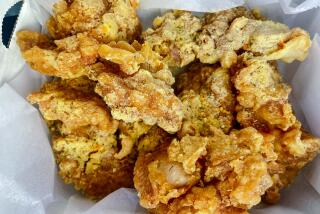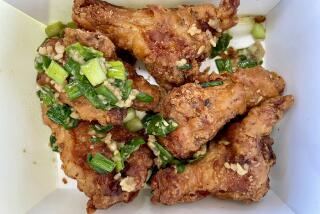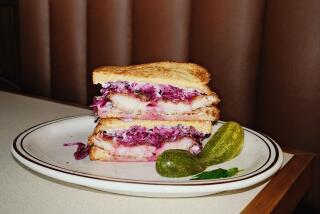London street markets reborn
London
A hunk of butter, a little garlic and a handful of mushrooms — Sporeboys owners David Robinson and Andrew Gellatly toss fresh chanterelles, portobellos and cepes in a sauté pan, sprinkle a bit of pecorino cheese and parsley on top and throw it all between two slices of fresh-baked bread.
Eager lunchtime crowds line up for their sandwiches at the London markets where the two set up their stall. Their odd but delectable creation is typical of the diverse offerings at the outdoor markets, which have become magnets for office workers and shoppers looking for a taste of something different.
London has always been a hub for commerce, its street markets central to city dwellers’ lives. But something is changing lately in these long-established shopping spots, a shift that reflects the capital’s new dynamism and diversity.
The city is booming, brimming with a new confidence as real estate prices spiral upward, financiers seek to snatch New York’s mantle as the premier global trading hub and London becomes the favored destination of increasingly mobile young Europeans. Its street markets are some of the best places to see the rapid evolution up close.
Markets that grew up along the “drovers’ paths” where herders once led livestock to slaughter are now filled with fabulous foods, stylish clothes and ingredients that demonstrate the international flavor of a city where more than a quarter of the inhabitants were born overseas.
As London grows wealthier, its markets provide evidence of residents’ increasingly tony tastes. With immigrants streaming into the city, the markets have become places to snack on fried plantains from the Caribbean and watch women in vividly colored African robes shop for beans and dried fish from home. And they’re among the best spots to sample the great foods that Britons have recently begun discovering after centuries of culinary mediocrity. Goodbye boiled vegetables, hello gastro-pubs and the organic revolution. Even bangers and mash have gone upscale.
London “has got 10 million people, it’s cosmopolitan, people are looking for something new,” said Rob Athill, who hopes the stall he and his wife have opened at Exmouth Market in the hip Clerkenwell neighborhood will kick-start their new Vietnamese coffee business. “This is the place to get noticed.”
Also driving the markets’ growth are Britons’ growing dissatisfaction with mass-produced food in supermarkets and their worry about the environmental impact of the “food miles” those products travel before they get to them.
A nation once happy to subsist on pub grub and crisps (potato chips) is learning to love fresh food that’s produced nearby and eaten in season. The outdoor markets are full of small businesses such as Two Fishwives, which sells gourmet fishcakes and pies, and a cider enterprise run by owner Barry Topp, who presses his own hard cider.
Portobello Road’s antiques fair and the crafts and fashions of Camden Town have long been stops on the London tourist trail. But the real treasures are lesser known, the shopping spots where at-home cooks fill canvas bags with fresh vegetables and bread, and locals chat with their neighbors and sip pints of beer.
These markets are the places where Londoners bring their kids to hang out on a sunny Saturday, stop for lunch and schmooze with whomever happens to stroll by. They’re perfect spots for visitors to catch a glimpse of everyday community life in a fast-changing city that’s still holding tight to its history. And be sure to stay for a bite while you’re there.
Borough Market is the scrumptious granddaddy of London’s food destinations, first established when the Romans occupied the city and settled in its current location — just south of the Thames River, near London Bridge — for 250 years. It’s a favorite stop for foodies hunting down that perfect French salami or Scottish sausage, and it’s often packed on Saturdays with Londoners getting ready for weekend dinner parties.
Some complain prices are inflated, but the market’s range and quality are incomparable, and an hour spent browsing can easily make lunch unnecessary: Many stalls offer samples to passersby, who gorge happily on cheeses, sweets and much more. More than 125 vendors in the enormous, covered complex offer a dizzying number of choices: buffalo Parmesan, lamb from Scotland’s remote Orkney Islands, traditional English pork pies, organic fruit smoothies, 1,700 kinds of beer in one shop alone.
“It’s my economic salvation,” said Topp, the cider maker. Shoppers, he said, value the market’s fresh goods and the care producers take with them. “There are so many stalls that are cooking their own products, you can taste them — there’s somebody on hand who’s quite happy to talk to you.”
Broadway Market in east London’s Hackney district sprang back to life in May 2004 after decades of dormancy. Part of the path along which herders once drove sheep toward the slaughterhouses of central London, it has a long history as a trading hub but sank into disuse in the 1980s as deprivation gripped the surrounding neighborhood. Now Hackney is a thriving, diverse — if still gritty — area where artists, writers and young professionals rub elbows with Caribbean, Turkish and Vietnamese immigrants.
Residents and business folks banded together to restart the market, and every Saturday the street (also called Broadway Market) is crowded with shoppers and snackers. Tucked between London Fields park and Regent’s Canal, it’s a showcase for Hackney’s artsy gentrification, which has caused some local tensions.
Nearby, Robert Cooke still serves meat pies, mashed potatoes and jellied eels — an East End working-class specialty — at F. Cooke, the restaurant his great-grandfather opened in 1862. Outside the Nutritious Food Gallery, a Caribbean fish shop, a vendor sells sweet fried plantains and rice with peas. Shopper Franny Moyle says she loves running into all her neighbors on her weekly visit to the market. “It’s brought this area to life again,” she said.
Columbia Road Flower Market and Spitalfields Market make a fun Sunday combination. Start at the outdoor flower market, which runs only on Sundays, from 8 a.m. till 2 p.m. The offerings vary by season; primroses, lilies, jasmine and amaryllis were on display one spring day, along with dozens of varieties of herbs and potted plants. Vendors with Cockney accents shout over one another: “Eight large, hardy violas for a fiver,” yelled one.
Cafes, bakeries and shops line Columbia Road and the market’s extension on Ezra Street. Walk down to Bethnal Green Road, whose sari sellers and Indian sweet shops testify to its place as a hub for London’s South Asian communities. Brick Lane’s Sunday market will appeal only to hardened bargain seekers, but cut through for a stop at one of London’s most popular bagel makers, a reminder that the neighborhood has been home to generations of immigrants.
Spitalfields Market, a cavernous indoor space packed with stalls and restaurants, is far from undiscovered. But Londoners still outnumber the tourists, and if you don’t mind crowds, it’s a fun place to browse. CDs, used and discounted books, funky jackets and jewelry, fresh tofu and leather handbags are among the offerings.
Exmouth Market is near the heart of the up-and-coming Clerkenwell neighborhood. The street it inhabits, also called Exmouth Market, has evolved rapidly in recent years, with design shops and restaurants moving into a once-scruffy strip. Only hints remain of Clerkenwell’s history as home to London’s Italian community; now stylish media types predominate.
A few food stalls expanded into a proper Friday and Saturday street market late last year. Among the offerings: Jollof Pot’s tent dishes out spicy Ghanaian stews with rice, while Athill and his wife Tuyen Hong’s Cà Phê VN serves strong Vietnamese coffee at low Asian-style tables with stools. Nearby, a whole hog roasts on a spit. Many of the street’s restaurants and shops offer food at outdoor stalls. Middle Eastern-Mediterranean Moro sells paella, and Spanish deli Brindisa doles out chorizo sandwiches.
Brixton Market, in the city’s south, is a shopping hub for London’s large African and Caribbean population. It spills onto the side streets surrounding Electric Avenue, the main drag, and fills several indoor pavilions.
Caribbean music playing on storefront speakers provides a festive soundtrack, and the brightly colored African robes on display are a visual treat. Specialized grocery shops sell African grains and spices and a dozen kinds of dried fish, along with cassava and yams.
Restaurants and food carts serve up Trinidadian rôti and Ghanaian specialties, and CDs and DVDs from Africa and the islands are plentiful.
“Anything that you can get in Africa, you can get in the market,” said Mafasser Hussain, owner of Brixton Fabrics, whose shelves are piled high with patterned fabrics in a rainbow of colors. “Food, clothes, anything ... that’s why people come here.”
Also worth a visit: Riverside Walk secondhand book market, daily along the Thames’ south bank; Marylebone Farmers Market, one of London’s most popular off Marylebone High Street; and Leadenhall Market, shops and restaurants in an ornate Victorian building, weekdays only in the financial district.
More to Read
Sign up for The Wild
We’ll help you find the best places to hike, bike and run, as well as the perfect silent spots for meditation and yoga.
You may occasionally receive promotional content from the Los Angeles Times.















